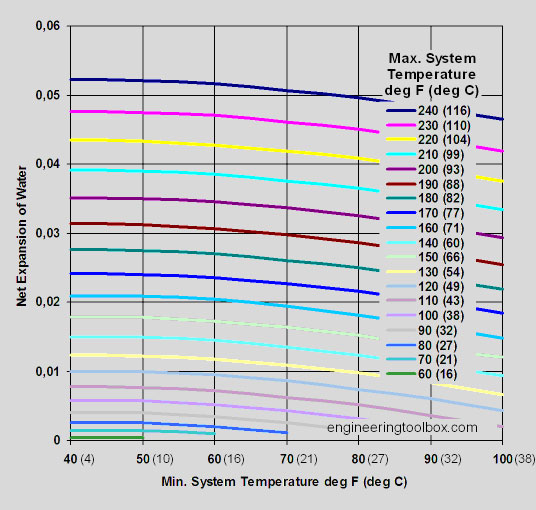Open Expansion Tanks
An open expansion tank is only relevant for Low Pressured Hot Water – LPHW – systems. The pressure is limited by the highest location of the tank.
The volume of an open expansion tank should be the double of the estimated expansion volume in the system.
An example of setting the volume of an open expansion tank as follows;
Heating System: 25.000 kcal/h (30 kW)
Water content in system total: 500 lt.
Temperature change: 10 °C => 90 °C
Expansion of water volume: % 3,55
The amount of water expansion = 500 x 0.0355 = 18 Liters.
Open expansion tanks should contain a minimum of 100 mm water level and posess an additional volume of % 40 – 45 from water level to the top of the vessel level. In such conditions we can generalize the result as, Tank volume should be twice the volume of the water expanded.
Apply a factor of safety coefficient of 2 = 18 x 2 = 36 Liters
Outlet and Inlet Safety Valves:
Empirical formulas ;
- Outlet pipe diameter Do = 15+1.5?Q/1000 mm
- Inlet pipe diameter Di = 15+?Q/1.000 mm
Note : Pipe diameters calculated via these formulas should not be lower than 1” .
- Do = 15 + 1.5 x ?(25.000/1.000) = 22.5 mm.
- Di = 15 + ?(25.000/1.000) = 20 mm.
With the consideration of minimum value standard directs, we choose safety outlet and inlet as 1” .
Notes :
- Over flow oulet of Open expansion tank diameter is advise to be a minimum of 2” .
- There should be no valves between Boiler and Expansion tank, safety outlet and inlet pipes.
- If 2 or more boilers works as cascades, in the same system, every unit has to have an independent expansion tank.
- Safety outlet & inlet pipes should be connected to the system together. Outlet pipe discharges the steam in an emergency and inlet pipe is used to feed the water decreased from the system.
- It should be considered that all the air in the plumbing system must contain air discharge valves and air should be fully discharged from the system before operating boilers.
- An open expansion tank has the disadvantage of allowing air to enter the system via absorption in the water. In general it must be located in the top of the building where it also may be exposed to freezing.


 Canada
Canada